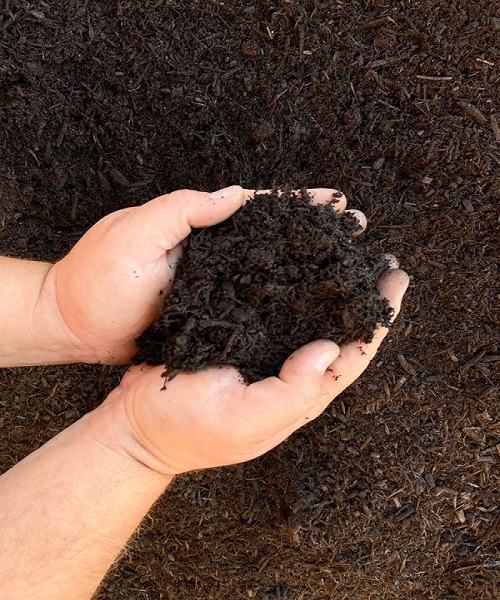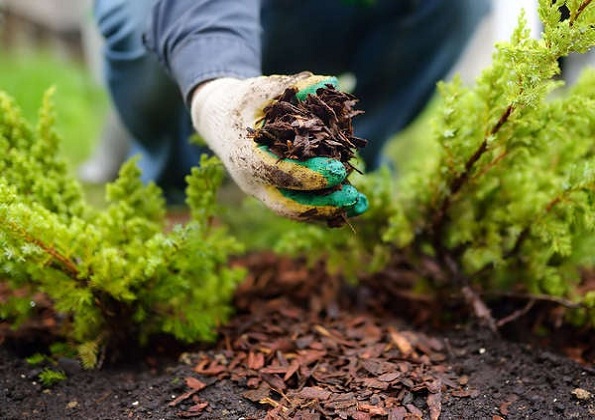To keep weeds from growing in your flowerbeds, you need to avoid making the 4 most common mulching mistakes. Each of these mistakes can lead to more weeds and more work trying to keep them under control.
There’s no denying that a covering of mulch can greatly aid in weed prevention. Mulch is great for keeping weeds at bay, but it also has a significant impact on the well-being and growth of the annuals and perennials you cultivate in your beds.
Using Super-Shredded Mulch or Ultra-Fine Mulch
In the landscaping business, making ultra-fine mulch has been a major focus during the past decade. These mulches, which are often referred to as triple shredded or ultra-fine shredded mulch, are not recommended for use in flowerbeds.
While ultra-fine mulches may have a stunning initial appearance, they are unfortunately terrible at stifling and inhibiting weed growth. Worse, they do a poor job of insulating the soil and keeping moisture levels up for plants.
Extremely fine mulch frequently resembles soil more than mulch. To create the end result, the selected material is repeatedly fed through a shredder. The mulch is refined with each subsequent sifting.
It does spread more quickly, that much is certain. The “appearance” of the soil can be very attractive in flower gardens. Well, until the weeds grow quickly and take over. Weed seeds can sprout in ultra-shredded mulch because of how fine it is.
This makes it easy for weeds to grow from seeds that blow in or are brought in by animals and birds. Mulch that is extremely fine decomposes rapidly into the ground. Unfortunately, this necessitates the use of more and more mulch, which can be rather costly.
Recommended Mulch Types
Single or double shredded products are the greatest mulch option to use for flowerbeds. These are still sturdy enough to prevent weed growth and keep the soil warm. As far as mulch goes, hardwood and hardwood bark are at the top of the list. They are excellent at the aforementioned tasks, and as they decompose, they enrich the soil with nutrients.

Not mulching deeply enough
Putting only an inch or two of mulch in your flowerbeds will never be sufficient. The weeds will still find a way into your soil even with this. Furthermore, it is not thick enough to provide adequate insulation for plants or to retain water.
Mulch should be spread at least 4 inches deep in flower beds for best results. What’s more is that six inches is excellent! Mulch of that depth is substantial enough to effectively prevent weeds from germinating. It also has the added benefit of shielding the soil from the sweltering summer sun.
A thicker layer of mulch can reduce the number of weeds in your garden and the amount of time spent weeding throughout the duration of the summer.
Last but not least, make sure there are more plants than mulch in your flowerbeds. A denser plant cover makes it harder for weeds and weed seeds to germinate and grow. Better yet, you’ll need a lot less room for mulching.

Turn Your Mulch Over by Raking
One of the most popular misconceptions about mulching is that you may rake it and turn it over to “freshen” it. And it certainly leads to a never-ending cycle of weeding.
Existing mulch should never be disturbed, even though doing so may seem like a great way to liven up your flowerbeds. Mulch creates a barrier that prevents weed seeds from germinating in your flower beds. In addition, as long as that obstruction remains in place, the seeds will not be able to reach the ground and begin growing.
When you rake or flip over your mulch, the seeds that were sitting on top can easily settle into the new layer. In addition, a mulch covering provides additional insulation and moisture retention, both of which are essential for germination.
Mulch shouldn’t be raked or turned at any point. Not in the beginning of the spring or at any other point during the season. Putting down a new, thin layer of mulch on top of your flower beds is an easy way to update their appearance. The soil’s protective covering will remain intact, and weed seeds won’t have a chance to germinate.
Not Mulching In The Fall
The biggest and best most prevalent mistake is the one we save for last: failing to mulch your flowerbeds in the fall. Putting down a new layer of mulch in the spring is essential, but mulching in the fall is just as crucial. Perhaps even more so, in fact.
Most mulch in flowerbeds will have decomposed by the time autumn rolls around. When this occurs, weed seeds from all over can be carried in on the wind during the late fall and winter. This will result in an unprecedented amount of weed growth next spring.
The perennials you have cared for all year would benefit greatly from a fresh, thick coating of mulch applied in the fall to help shield them from the harsh winter weather. Perennial plant roots may be damaged by winter’s repeated cycles of thawing and freezing.
A thick layer of mulch, however, can maintain more constant soil temperatures, ensuring that plants can easily endure the winter.


